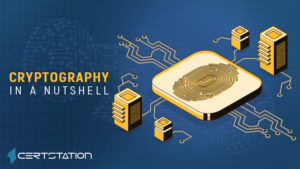
What is Cryptojacking?
Cryptojacking, or Cryptomining malware, is the unlawful use of someone else’s computer to mine cryptocurrency. Hackers do this by either having the victim click on a malicious link in an email that loads crypto mining code on the computer, or by infecting a website or online ad with JavaScript code that auto-executes once loaded in the victim’s browser.
What is Cryptomining?
The practice of “cryptomining” or cryptocurrency mining involves adding numerous cryptocurrency transactions and evidence of mining work to the blockchain ledger. As a miner works to produce the block contents and algorithmic outputs that make up new blockchain transactions, they are said to be creating a new “coin” of a particular kind in the blockchain.
A growing scourge that can take over web browsers, cryptojacking is a developing online threat that conceals on a computer or mobile device and uses the machine’s resources to pit methods of online money known as cryptocurrencies. From desktops to laptops, to smartphones, it can affect all manner of devices. The motive, like most other spiteful attacks on the computing public, is profit, but as opposed to many threats, it’s intended to stay totally concealed from the user.
How cryptojacking affects your business?
Whether you have a personal computer or you own business with a number of computers, you are equally prone to this threat. Cryptojacking attack can cause a number of problems if it ends up flooding a company’s computers. Here are some of them.
Consumption of resources: Your company is likely to observe the phenomenal rise in your energy bills, compromised systems exploit more resources than expected level , producing many obstacles such as partial or complete denial of services condition, system failure, services disruption, instable services provision, and more.
Technical glitches: The huge majority of computers in the world aren’t technologically up to the task of taking out cryptocurrencies. If cryptojacking malware makes its way onto your IT system, it won’t be long before your company begins to lose money on technological support, or even on buying new computers.
Your company’s cybersecurity: Data theft might not be among the cryptojackers’ top priorities, but the fact that these cybercriminals manage to get onto your computers means that there is a grave cybersecurity problem at your organization.
Malware infection: Conducted with malware, the cryptojacking attack could represent a huge risk to an organization because malware could be used for any kind of attack from spying to ransom demand to cyberespionage.
Unauthorized access: Once the attacker has affected your systems from one way or another for carrying out cryptojacking attack, they have unauthorized access to your systems and this access could be used for executing nearly any malicious action.
How is cryptojacking attack carried out?
Any weak point can be exploited to conduct a cryptojacking attack, but there are some very common methods to execute a malicious attack, some of which are:
Malware infection: An attacker can use this method to infect the target systems from one way or another to consume systems’ resources and exploit the systems for cryptojacking.
System vulnerabilities: An attacker could take advantage of known vulnerabilities compromise the susceptible system to carry out the cryptojacking attack.
Phishing: Attacker could launch phishing campaign and infect the victims’ systems to carry out the attack.
Malicious websites: An attacker could host malicious websites and run malicious scripts on visitors’ browsers to carry out cryptojacking attack, also referred to as ‘drive-by-attack’, with the user on the website.
How to detect cryptojacking?
It can be difficult to detect cryptojacking attack due to its unpopularity and low noisiness, particularly if only a few systems are compromised. Here’s what will work:
Train your help desk to look for signs of cryptojacking: Occasionally, the first sign is a spike in help desk grievances about slow computer performance, which raise a red flag to examine further. Other indications help desk should look for might be overheating systems, which could cause CPU or cooling fan failures.
Organize a network monitoring solution: Cryptojacking is easier to perceive in a corporate network than it is at home because most consumer end-point solutions do not notice it. Cryptojacking is easy to detect via network monitoring solutions, and most corporate companies have network monitoring tools. The IT administrators have to set the strong baseline of network resources utilization at peak hours and at idle hours as well, while having this baseline could help detect unexpected spikes in systems and resources utilization.
How to prevent cryptojacking?
To reduce the risk of your organization falling prey to cryptojacking, these steps should be followed.
Conduct security awareness and training programs: Integrate the cryptojacking threat into your security consciousness training, concentrating on phishing-type efforts to load scripts onto users’ computers. Training will help shield you when technical solutions might fail, and phishing will continue to be the main technique to deliver malware of all types. Employee training won’t help with auto-executing crypto-mining from visiting genuine websites.
Install an ad-blocking or anti-crypto-mining extension on web browsers: Use browsers that avert scripts implementation and also use the scripts blocking browser extensions such as NoScript, AdBlock Plus, & AdBlock.
Use endpoint defense that can detect known crypto-miners: A number of the endpoint protection/antivirus software vendors have added crypto-miner detection to their products. Antivirus is one of the best things to have on endpoints to try to defend against crypto-mining. If it’s recognized, it’s likely to be detected. One needs to be aware, however, that crypto minor authors are continually altering their methods to avoid detection at the endpoint.
Apply serious security updates and patches: It is highly advised to use new applications and hardware and also apply security covers to applications and hardware.
Monitor your resources utilization: You must be watchful of critical systems and examine the unforeseen hikes of resources.
Some Real-world cryptojacking examples
Cryptojackers have formulated numerous schemes to get other people’s computers to mine cryptocurrency. While most are not new, crypto-mining delivery approaches are often derived from those used for other types of malware such as ransomware or adware. Here are some real-world examples:
Reprobate employee seizes company systems
Earlier this year, at the EmTech Digital conference, Darktrace told a tale about a European bank that was undergoing some rare traffic designs on its servers. Night-time processes were painfully slow, and the bank’s analytic tools didn’t realize anything. Darktrace revealed that new servers were coming online during that time. A physical check of the data center later divulged that a reprobate staffer had established a cryptomining system under the floorboards.
Serving cryptominers through GitHub
In another incident, Avast Software in March realized that cryptojackers were using GitHub as a host for cryptomining malware. They discovered genuine ventures from which they generate a cleft project. The malware is then concealed in the directory structure of that cleft project. The cryptojackers, using a phishing scheme, bait people to download that malware through, for instance, a caution to inform their Flash player or the promise of an adult content gaming site.
Conclusion
Crptojacking may sound like a gentle threat compared to other more aggressive forms of cybercrime that cause instant harm and financial damage. There’s no doubt that most coin mining scripts do not damage computers or steal users’ data, but they hugely influence the complete performance of personal and business devices. Cryptojacking drains CPU processing resources to back its coin mining processes, decelerating the implementation of programs and applications in the process. This may be considered as a slight inconvenience, but organizations can suffer noteworthy losses in the form of amplified IT support tickets, higher electrical bills and reduced output.




